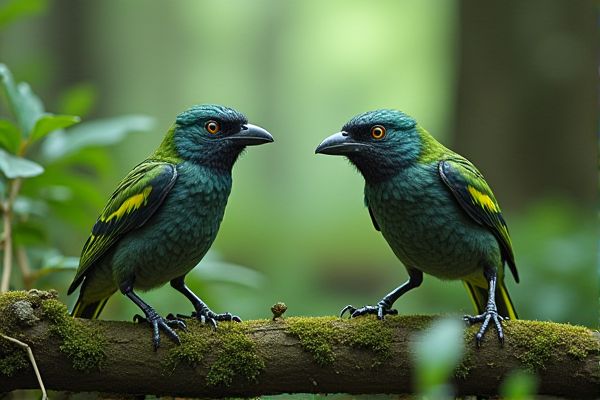
AI plays a crucial role in biodiversity conservation through advanced data analysis and monitoring techniques. Machine learning algorithms can identify species and their habitats, aiding in the detection of endangered populations and environmental changes. Drones equipped with AI technology facilitate real-time surveillance of ecosystems, enabling timely interventions. Predictive modeling helps in assessing the impacts of climate change, guiding conservation efforts to target vulnerable species and areas effectively.
AI usage in biodiversity conservation
Habitat Monitoring
AI can enhance biodiversity conservation by effectively analyzing vast amounts of ecological data, leading to better habitat monitoring. For instance, using AI algorithms, researchers can track species distribution and habitat changes in real-time. Such insights can inform conservation strategies, increasing the chances of preserving endangered species. The integration of AI tools like remote sensing in institutions like the World Wildlife Fund can optimize resource allocation for habitat protection.
Species Identification
AI technologies can enhance species identification through image recognition and data analysis. For example, machine learning algorithms can analyze photographs from sources like the iNaturalist platform to accurately identify various species. This capability offers the potential for quicker assessments of biodiversity and targeted conservation efforts. Improved species identification may lead to more effective management strategies and resource allocation in conservation projects.
Poaching Prevention
AI technologies can significantly enhance biodiversity conservation efforts, particularly in poaching prevention. For instance, machine learning algorithms can analyze patterns in wildlife data and predict potential poaching incidents, allowing organizations like the World Wildlife Fund to allocate resources more effectively. Drones equipped with AI can monitor vast areas, identifying illegal activities with greater accuracy. The ability to leverage real-time data may lead to improved protection strategies for endangered species.
Climate Change Impact Analysis
AI can enhance biodiversity conservation by analyzing vast datasets to identify species populations and habitats. For instance, machine learning algorithms can predict changes in biodiversity as a result of climate change, offering insights into necessary interventions. By integrating data from sources such as the Global Biodiversity Information Facility, these tools can improve decision-making for conservation strategies. This approach increases the chances of effectively maintaining ecosystem balance amid ongoing environmental challenges.
Citizen Science Support
AI can significantly enhance biodiversity conservation efforts by analyzing vast amounts of ecological data more efficiently than traditional methods. For example, platforms like iNaturalist enable citizen scientists to contribute observations, which AI can categorize and analyze to track species populations. This integration of AI allows for better monitoring and quicker responses to environmental changes, increasing the chances of successful conservation initiatives. The potential for improved data collection and analysis could lead to more informed decision-making in conservation strategies.
Ecosystem Health Assessment
AI technologies can enhance biodiversity conservation efforts by analyzing vast datasets to identify patterns in species distribution and habitat loss. For example, machine learning models can predict the impact of climate change on ecosystems, allowing organizations such as the World Wildlife Fund to allocate resources more effectively. AI-driven tools can optimize ecosystem health assessments by providing real-time monitoring of environmental conditions. This can lead to improved decision-making and potentially greater success in conservation initiatives.
Invasive Species Control
AI can enhance biodiversity conservation efforts by offering precise monitoring and data analysis capabilities. For example, machine learning algorithms can identify patterns in invasive species populations, allowing for timely interventions. These tools can optimize resource allocation for projects aiming to protect threatened ecosystems. By leveraging AI, organizations like the World Wildlife Fund can increase their chances of success in curbing the impact of invasive species.
Genetic Diversity Analysis
AI can enhance biodiversity conservation efforts through improved genetic diversity analysis. For instance, organizations like the World Wildlife Fund utilize AI algorithms to analyze genetic data efficiently. This capability may lead to more accurate assessments of species health and the potential for successful breeding programs. The integration of AI tools could increase the chances of preserving endangered species by identifying genetic traits that promote resilience.
Wildlife Population Management
AI can enhance biodiversity conservation efforts by analyzing vast amounts of ecological data, leading to more informed decisions. For instance, AI-driven models can predict wildlife population trends, potentially improving management strategies for species like the African elephant. The ability to identify patterns in habitat loss or climate change effects allows for targeted conservation interventions. Overall, integrating AI tools may increase the chances of preserving endangered species effectively.
Predictive Modeling for Conservation
AI has the potential to significantly enhance biodiversity conservation efforts through predictive modeling techniques. By analyzing vast datasets, such as species population trends or habitat conditions, AI can forecast changes and identify critical areas requiring intervention. This approach can optimize resource allocation, allowing organizations like the World Wildlife Fund to focus their efforts on the most impactful conservation strategies. Increased accuracy in predictions also provides a chance for early action, potentially improving the survival rates of endangered species.
 techknowy.com
techknowy.com